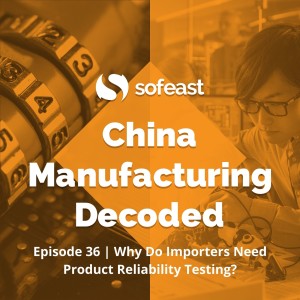

Adrian and Renaud discuss the topic of product reliability testing. What is this type of testing, when do we carry it out, what are the risks of not doing the testing, and what does it cost? These questions and many more are answered, because today, more than ever, it's so important for importers to protect themselves against expensive recalls and lawsuits which may occur if your products don't reach expected reliability, quality, and, as a knock-on effect in many cases, safety standards.
Ultimately, you'll discover why, for most products, skipping reliability testing during the NPI process is simply not worth it!
Show Notes00:00 - Introduction
02:37 - A summary of WHAT product reliability is. Some examples are given, in particular, that of a women's razor that must be able to withstand the bathroom and shower environment and also a smartphone which needs to withstand daily use.
05:19 - If a product is NOT reliable, how could this affect the importer? You will face returns, bad reviews, and in the case of failures that lead to safety issues, you may have to recall a batch, be prosecuted in court, pay heavy damages, etc.
06:36 - What typically causes reliability issues in a new product? The causes of reliability issues can be broken down into categories:
- Design: Poor design is usually the top cause of reliability problems later on. The infamous case of the unsafe Samsung Galaxy Note 7 was down to a poor design that allowed the batteries to catch fire in certain circumstances.
- Manufacturing: Component manufacturers or manufacturing at the main assembly site can also cause reliability issues. An example is given of specifying the wrong kind of glue that later causes product failure (specifying the wrong materials or components is a type of design failure, too).
13:00 - Why product reliability is ever more important in these days of the internet when disgruntled users will soon write bad reviews. There is no one product category where users wouldn't complain about an unreliable product. Products for children would be an obvious target where brands can't afford to upset consumers, but on the other hand, something as simple as a takeaway coffee cup could also injure and upset consumers, too.
14:31 - The importance of understanding safety standards when developing a new product and planning ahead for any and all possible failures that could affect consumers.
15:41 - Will hardware startups, who may be new to reliability testing, get any support to define and plan for potential product failures from 3rd party companies (like Sofeast) who conduct the testing for them? Yes, although the developer really needs to understand their own users and how they may misuse the product better than anyone else. We will usually discuss the relevant regulations and potential risks with a customer who is developing a new product where needed, challenge their design and prototypes to assure that they're going in the right direction for their goals for the product, and we also often perform risk analysis and a design FMEA, too.
17:56 - How to confirm the performance of the product during development.
18:52 - How to push the limits of the product to work towards reliability during development. Some ideas of what to test to simulate the extremes that the product can be pushed to in order to see what fails first. This often uncovers the main weaknesses of a product's design.
20:56 - Reliability and compliance testing during mass production. Samples from the pilot run can be used to confirm that everything is OK with the product design, but also, importantly, the manufacturing process by subjecting them to typical usage over, say, 2 years. Compliance testing should also be done on these early pre-production pilot run samples, too.
24:19 - Why some companies still take the risk of not performing reliability testing. Those with less experience tend to place a lot of trust in their manufacturer, assuming that they will not provide products which later turn out to have reliability issues.
25:43 - The types of reliability testing that may be used. These vary per the product type, but here are some options:
- Cycling the product from low to high temperature, humidity testing, salt spray testing on exposed metals, mechanical tests like drop and vibration tests, flexing cables, lifecycle testing (HALT), and more.
- Packaging reliability testing is also a consideration, as it is often a part of the product offering these days and will need to reliably protect your product and its retail packaging during transit and storage. So for this, there will be drop tests, vibration tests, atmospheric testing, and compression testing, and more.
- Batteries, in particular, will have many types of tests, such as charge/discharge cycling, drop tests, thermal tests, and more.
31:33 - Some real examples Renaud has seen of product disasters that reliability testing uncovered. Products that catch fire (!) are a constant threat and something seen a number of times, but also products which instantly break, scratch or corrode immediately, and more! 🙈
33:52 - Why the worst safety issues often stem from reliability problems. We discuss the link between reliability, quality, and safety, and how they overlap. How reliability is usually focused on during product development and how quality is focused on during manufacturing. If both are handled well, there should be no safety issues.
37:18 - How much does reliability testing actually cost? Most consumer products that are not made in vast quantities the product reliability testing can range between $300-3,000. When companies understand the risks that are avoided by the testing they usually see it as a worthwhile investment.
39:15 - Reiterating why reliability testing is not to be skipped for most products.
41:40 - Wrapping up.
Related content to read next...Here are a few blog posts about reliability testing that Renaud wrote earlier:
- Product Reliability Testing | 7 FAQs - this is a further introduction to the topic.
- Reliability Testing Plan For A Home Appliance (an Electronic Hairbrush) in China [Example] - this shows you a real example of a testing plan for a pretty common electronic product.
- Why NOT to skip reliability testing on electronic products from China - a cautionary post showing what can go wrong and how to avoid issues.
- We discussed product packaging, so learn more about common packaging types and features in this guide.
- Our guide on battery choice for importers of electronics also covers battery testing in some detail, and you can read that here.
- Watch our playlist of videos on battery testing and quality here.
- Also, at Sofeast, we provide product reliability testing (and packaging testing) for our customers, too, so take a look and get a quotation for your project. 👍
- Connect with us on LinkedIn
- Send us a tweet @sofeast
- Prefer Facebook? Check us out on FB
- Contact us via Sofeast's contact page
- Visit our website at Sofeast.com
- Subscribe to our YouTube channel
There are more episodes to come, so remember to subscribe! You can do so in your favorite podcast apps here:
- Apple Podcasts
- Spotify
- Stitcher
- Google Podcasts
- TuneIn
- Deezer
- iHeartRADIO
Get in touch with us
-
- Connect with us on LinkedIn
- Contact us via Sofeast's contact page
- Subscribe to our YouTube channel
- Prefer Facebook? Check us out on FB
More Episodes
All Episodes>>Create Your Podcast In Minutes
- Full-featured podcast site
- Unlimited storage and bandwidth
- Comprehensive podcast stats
- Distribute to Apple Podcasts, Spotify, and more
- Make money with your podcast












